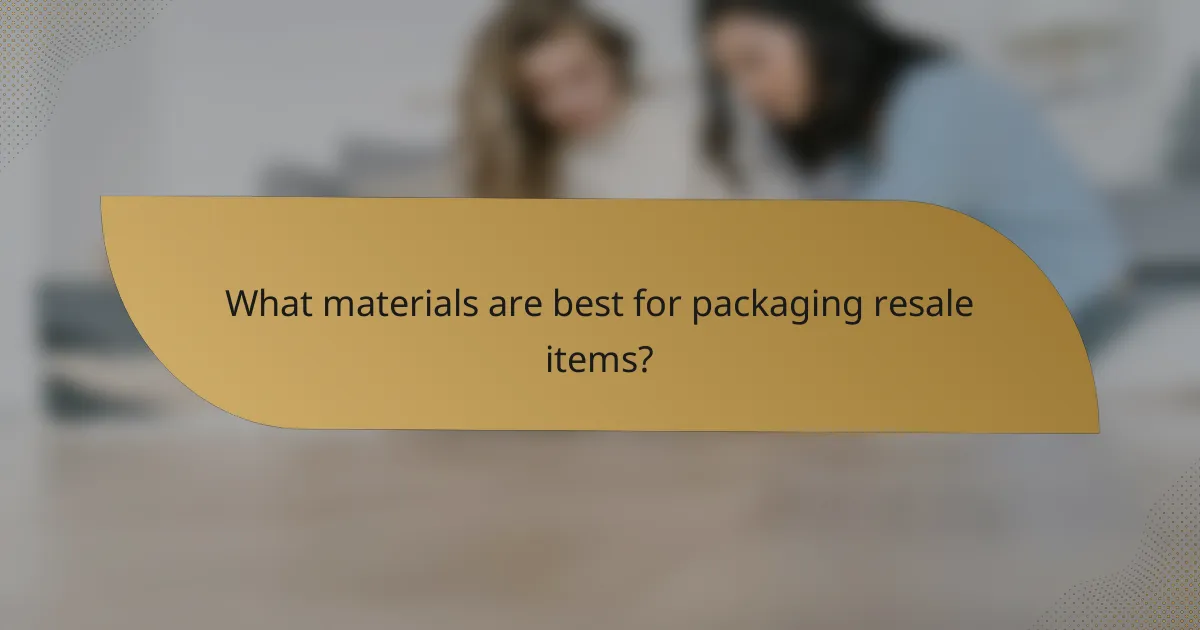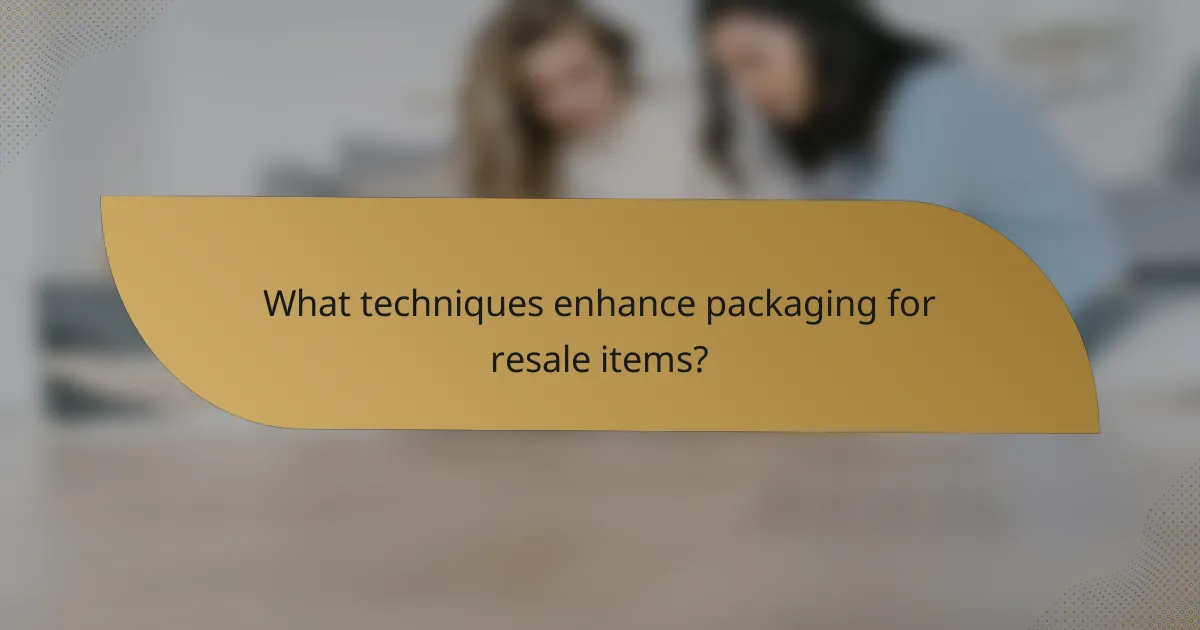Effective packaging for resale items is crucial for ensuring product safety and enhancing customer appeal. Utilizing materials such as cardboard, biodegradable plastics, and glass containers can provide both protection and sustainability. Additionally, employing techniques like custom printing and proper sealing helps maintain compliance with safety standards, ultimately improving the overall presentation and reliability of the packaged products.

What materials are best for packaging resale items?
The best materials for packaging resale items include cardboard boxes, biodegradable plastics, glass containers, recycled paper, and foam inserts. Each material offers unique advantages in terms of protection, sustainability, and cost-effectiveness, making them suitable for different types of products.
Cardboard boxes
Cardboard boxes are a popular choice for packaging due to their lightweight nature and strength. They can be easily customized in size and shape, making them versatile for various items. When selecting cardboard, consider the thickness and weight capacity to ensure adequate protection during transit.
For added durability, opt for double-walled cardboard for heavier items. Additionally, using printed boxes can enhance branding and customer experience, making your products stand out.
Biodegradable plastics
Biodegradable plastics are an eco-friendly alternative to traditional plastic packaging. They decompose more quickly in landfills, reducing environmental impact. When choosing biodegradable options, look for certifications that confirm their compostability and safety for the environment.
These materials are suitable for items that require moisture resistance, such as food products or electronics. However, they may be slightly more expensive than conventional plastics, so weigh the benefits against your budget.
Glass containers
Glass containers provide excellent protection and are ideal for packaging liquids or fragile items. They are non-reactive, ensuring that the contents remain uncontaminated. Glass is also recyclable, which appeals to environmentally conscious consumers.
Keep in mind that glass is heavier and more fragile than other materials, which may increase shipping costs and the risk of breakage. Consider using cushioning materials inside the container to prevent damage during transport.
Recycled paper
Recycled paper is a sustainable option for packaging that can be used for wrapping or cushioning items. It is lightweight and cost-effective, making it suitable for various products. Using recycled paper helps reduce waste and supports eco-friendly practices.
When using recycled paper, ensure it is of good quality to provide adequate protection. You can also customize it with prints or branding to enhance the unboxing experience for customers.
Foam inserts
Foam inserts are essential for protecting delicate items during shipping. They can be molded to fit specific products, providing a snug fit that minimizes movement and potential damage. Foam inserts are particularly useful for electronics, glassware, and other fragile goods.
When selecting foam, consider the density and thickness to match the level of protection needed. While they can be more expensive than other cushioning materials, their effectiveness in preventing damage can save costs in returns and replacements.

What techniques enhance packaging for resale items?
Enhancing packaging for resale items involves using effective techniques that improve presentation, protection, and compliance. Key techniques include custom printing, sealing methods, labeling standards, and protective cushioning, each contributing to the overall quality and appeal of the packaged product.
Custom printing
Custom printing allows businesses to create unique packaging that reflects their brand identity. This can include logos, product information, and eye-catching designs that attract customers. Utilizing high-quality inks and materials ensures durability and visual appeal.
When considering custom printing, evaluate options like flexography or digital printing based on your budget and production volume. For smaller runs, digital printing may be more cost-effective, while flexography can be advantageous for larger quantities.
Sealing methods
Effective sealing methods are crucial for ensuring the integrity of packaged items. Common techniques include heat sealing, adhesive sealing, and tamper-evident seals, each providing different levels of security and protection. Choosing the right method depends on the type of product and its sensitivity to environmental factors.
For example, heat sealing is ideal for food items, while tamper-evident seals are essential for pharmaceuticals. Always test seals to ensure they withstand handling and transportation conditions.
Labeling standards
Adhering to labeling standards is vital for compliance and consumer safety. Labels should include essential information such as product name, ingredients, usage instructions, and any relevant warnings. Familiarize yourself with local regulations, such as the FDA guidelines in the U.S. or EU labeling requirements, to avoid legal issues.
Consider using clear, legible fonts and contrasting colors to enhance readability. Additionally, ensure that labels are securely attached and resistant to wear during shipping and handling.
Protective cushioning
Protective cushioning safeguards items from damage during transit. Options include bubble wrap, foam inserts, and biodegradable packing peanuts, each offering varying levels of protection. The choice of cushioning material should align with the fragility of the product being packaged.
For delicate items, use thicker cushioning materials and ensure they fit snugly within the packaging to minimize movement. Regularly assess your cushioning methods to adapt to new products or shipping methods, ensuring optimal protection at all times.

What safety standards must packaging meet in e-commerce?
Packaging for e-commerce must adhere to various safety standards to ensure product protection during shipping and handling. These standards help minimize damage, ensure compliance with regulations, and enhance customer satisfaction.
ASTM D4169
ASTM D4169 outlines the performance testing for shipping containers and systems. It provides a framework for evaluating how packaging withstands various distribution environments, including vibration, compression, and temperature changes. Adhering to this standard helps ensure that products arrive at their destination intact.
When implementing ASTM D4169, consider conducting tests that simulate real-world shipping conditions. This may involve drop tests, stacking tests, and environmental exposure assessments to identify potential weaknesses in your packaging design.
ISO 11607
ISO 11607 specifies the requirements for packaging used for terminally sterilized medical devices. This standard ensures that the packaging maintains sterility until the point of use, which is crucial for healthcare products. Compliance with ISO 11607 is essential for manufacturers in the medical field to meet regulatory expectations.
To comply with ISO 11607, focus on selecting appropriate materials and ensuring proper sealing methods. Regular validation of packaging processes is also necessary to maintain compliance and ensure product safety.
FDA regulations
FDA regulations govern the packaging of food, drugs, and medical devices in the United States. These regulations ensure that packaging materials are safe for contact with consumables and do not leach harmful substances. Compliance is critical for businesses in the food and pharmaceutical industries.
To meet FDA regulations, manufacturers should use approved materials and conduct regular testing for chemical migration. It is also advisable to keep abreast of any updates to FDA guidelines to ensure ongoing compliance.
UN packaging regulations
UN packaging regulations are designed for the safe transport of hazardous materials. These regulations classify materials and specify the packaging requirements to prevent leaks and spills during transit. Compliance is mandatory for businesses dealing with dangerous goods.
When packaging hazardous materials, ensure that you use UN-certified containers and follow the specific labeling requirements. Regular training for staff on handling and packaging hazardous items can help maintain compliance and safety standards.

How to choose the right packaging for different products?
Selecting the right packaging for various products involves considering factors like fragility, shipping distance, and environmental impact. Each of these elements plays a crucial role in ensuring that items arrive safely and sustainably at their destination.
Product fragility
Understanding product fragility is essential when choosing packaging. Delicate items, such as glassware or electronics, require cushioning materials like bubble wrap or foam inserts to prevent damage during transit. For sturdier products, simpler packaging may suffice, but always assess the risk of breakage.
A good rule of thumb is to use at least two inches of cushioning around fragile items. This helps absorb shocks and vibrations that occur during shipping.
Shipping distance
The shipping distance significantly influences packaging decisions. Longer distances may expose products to more handling and environmental factors, necessitating more robust packaging solutions. For instance, items shipped internationally often require stronger boxes and moisture-resistant materials.
Consider using double-walled boxes for long-distance shipments, as they provide additional strength. Additionally, ensure that the packaging is lightweight to avoid excessive shipping costs, which can add up over long distances.
Environmental impact
Choosing environmentally friendly packaging materials is increasingly important for consumers and businesses alike. Opt for recyclable or biodegradable materials to reduce waste and promote sustainability. Common eco-friendly options include cardboard, paper, and certain types of biodegradable plastics.
When selecting packaging, look for certifications like FSC (Forest Stewardship Council) for paper products or consider using materials made from recycled content. This not only helps the environment but can also enhance your brand’s reputation among eco-conscious customers.
